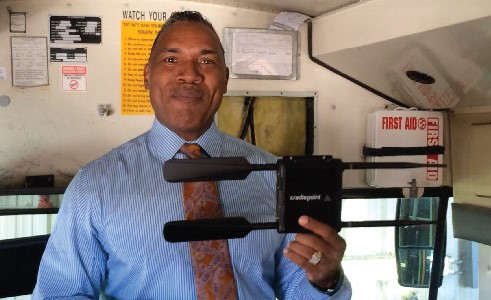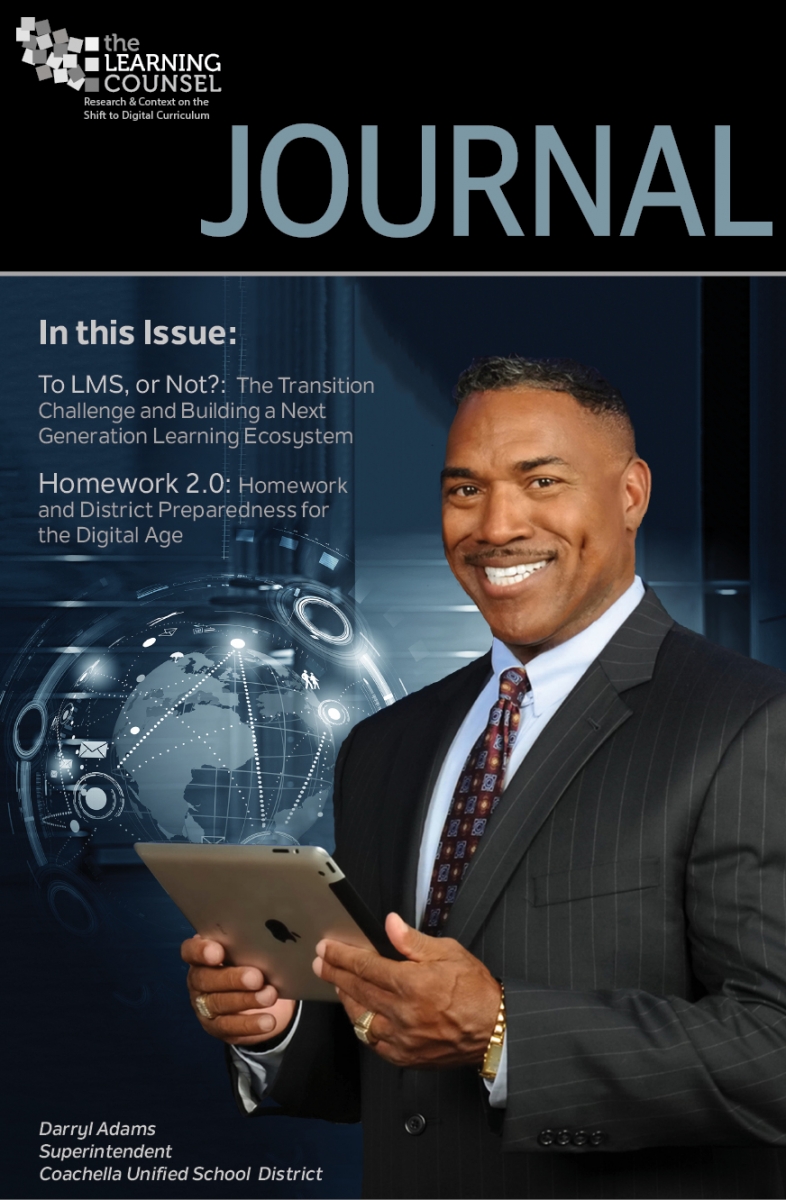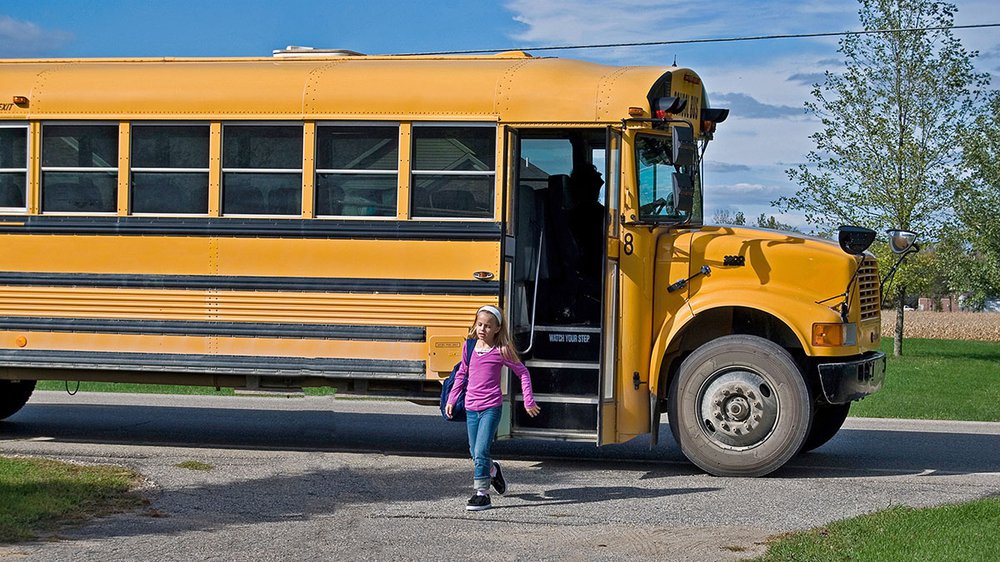The Learning Counsel has been taking a good hard look at the many options available to schools and districts to bring together all the pieces between curriculum and technology. Our hope is to better define where we’re going and help all to evolve a best practices approach for transformation.
As executives traverse the transition continuum path, there are many questions. No matter how far along this path a school or district is—some being rich in digital resources, and many others nearer the beginning of this undertaking—almost all lack enough organization.
As the Superintendent of Coachella Valley Unified School District in California, Dr. Darryl S. Adams oversees 20,000 students (all of which are on free or reduced price meals) and almost 1,000 instructors. His district spans a geography the size of the state of Rhode Island. The district is fully 1:1 from Pre-K through High School.
In this interview, Dr. Adams talk’s about his path and important pieces of the transition challenge.
What was the launch off point to transform Coachella? Tell me about where you started.
We started in 2012, and it involved the whole team. The board, the teachers, the parents, student groups—everyone got behind how to move from what was a 20th Century teaching model, to a 21St Century teaching and learning environment.
Can you share your strategy and process of moving over to devices and digital curriculum?
One of the most important things to consider when going down this path is: “What are the needs of your students?” What we saw is that our students were graduating, unprepared for college. So when we looked at that data-point, which said, “Of the students which you’re graduating, only 16% are graduating from college,” then we knew we had to do something different. We were not preparing them for college; our Mission Goal is: “How are we preparing students for College, Career, and Citizenship?” and, most importantly, “How are we doing that in the 21st Century?”
We explained that to our parents. We talked to our teachers about it. We talked to our Board, our politicians, and our business owners, and we told them we needed to transform, so that when these students come out, they’re prepared to go to college. Whether they go or not is up to them. But when they leave our district, they need to be prepared to go into a career, to help better the economic environment, and we want them to be good citizens, too.
To accomplish that, we knew we needed to use every tool that’s available – not only technology, but teacher training, the best curriculum, advanced placement courses, remediation courses when they’re necessary, summer school, after school, and also a virtual-school.
Ultimately, we were able to make it all happen, because we went to our parents and our public and asked them to vote for a general-obligation bond to fund that effort. It also paid for our whole Wi-Fi infrastructure, which is key to the whole connectivity issue. This may not be the funding option for everyone, but you got to find the money, and this is how we did it.
Over how long a period would you say your transformation took?
Our full implementation was over about three years, and I can say, at this particular point in time, we have a pretty good handle on everything. President Obama talked about what we’re doing because we’re providing 24/7 access by parking busses with Wi-Fi connectivity-routers on them in neighborhoods. And we’re powering those busses with solar panels so students who live in our trailer-home parks and didn’t have access before, now have access. We brought the connectivity to them for homework, and we’ve seen great results from that. 
What are your priorities now?
We want to continue to find innovative ways to have students transform their own thinking about their own learning. Personalized learning is the key to the future of every student—understanding what they need to do to take responsibility for their own learning.
And we want to make sure that our teacher-corps is really trained. We have an educational technology division now, not just an IT division. We’ve combined IT with EdTech. It’s important to be able to train teachers in the use of these tools but also to incorporate the curriculum. I want to make sure the teachers have their training so when they go into the classroom, they’re no longer the “sage on the stage”; they’re more like “the guide by the side,” and they’re facilitating and curating knowledge and information, working in concert with their students.
Tell us about how the early-adopters worked. Was it “all teachers on board” or did you have a small cadre of digitally inclined teachers who taught their peers? How did that work?
We had an application process that said, “Look, we’re going to have a pilot in the use of technology on mobile devices in the classroom, and we want teachers who are interested in incorporating a project-based learning environment with those devices. So, if you would like to participate in this pilot, then fill out this application.”
Of the 900 teachers we have, about 300+ applied and we selected 120. They became our “Pilot Teachers” and our cheerleaders for the effort because they had the devices and their students had the devices. We knew two things: (1) The teachers will tell other teachers, “This is the greatest thing since sliced bread,” and (2) The kids will go home and tell their parents, “This is the greatest thing since pizza.”
These teachers and students suddenly had the whole world at their disposal with all the applications that you can use, software programs; teachers were using programs, like Minecraft and other reading programs, literacy programs, and they were using projects – you know we have the Salton Sea in our district and students were coming up with ways to restore the Salton Sea? These are projects that really impact their lives. When other teachers saw that and the parents saw that, then the ground swell began, and you could see that everybody said, “We need to do this all the way.”
Do you have students who can’t make it to a physical school building?
We do. We established a Virtual Academy now that’s going to be able to help educate kids if they’re home schooled, independent-studies students, or students from other places. We have students who leave us to go up North with their parents to harvest the crops – they can still stay engaged with us, because they’re part of our Virtual Academy.
What are some of the tools apps software that you’re using? And some of the companies you are collaborating with?
We use a lot of the Apple applications, like Pages, Keynotes, and Numbers, and we use the Microsoft applications, like Word, PowerPoint, and Excel. So we want all our students to be well versed in using all applications that they’ll see in the business world or in their careers. Also, we’re teaching students how to write their own code and create their own apps.
We work with companies that are focused on using digital tools, and those that are being progressive and innovative. Houghton Mifflin Harcourt is one of our main supporters as far as using some of their Math and English Development tools. We have a big adoption with them and so it’s a key partnership for us. I really appreciate their support, because they do the training. They will embed trainers with you and they follow you to make sure that everything is in place and working effectively. I really and truly appreciate that, because once you start down this path, you want to have key partners who can ensure that you have the tools, the programs, and the products that you can use effectively.
On the backend, the tech side, we’re using companies like Airwatch. It’s important to have a good filtering system for your devices, because, you know, students can be mischievous and they’ll try to break out of your system. Airwatch is a mobile device management system that allows us to filter everything that’s coming in and make sure that we have a safe environment for our kids.
We’re teaching students how to be technicians and how to repair devices and replace a screen here or there – and also to help teachers. Sometimes they’re helping teachers more than the teacher is helping them with their devices. We’ve had students say, “We go to the Apple store and there’s the Apple Genius’; we want to be the Apple Genius,” and so we created a program where students are working to help support the program. When we deploy our devices, they help to configure those devices and get them out to their fellow students. It’s a beautiful thing to see that everyone is engaged in this from the adults to the students, all of them working together.
What are some of the barriers along this road that need to be considered?
In California, our County Office of Education is usually the one that works with the carriers and the cable providers to provide connectivity to the School Districts. But when we launched with the 20,000 devices the first time, we had a little problem and crashed the system. So that’s something to consider –connectivity and infrastructure is SO important. Digital natives and teachers today expect things to work and for the internet to be fast. It’s a different level of expectancy today. So that all needs to be ready and set.
Beyond that you need to have an open mind and be ready for anything. This is new territory. There are going to be issues. If you have a good team established, you will come up with solutions quickly and learn and build it up. We’re constantly coming up with solutions to problems, you know, like “We can’t ‘trench’ here and lay fiber”; or “The Wi-Fi connectivity to this school site has to go through air,” so you just find ways to do it, and find good, smart people to help you do it. My team has just been fantastic about finding solutions.
Infrastructure is key and also the access to the curriculum. How teachers and students get to the digital content must be answered early on. You don’t want to realize late in the game you have 10-20 or more logins for people. That can throw everything your working on sideways. Is it one LMS and SIS? We’re still learning the best combination of providers and tech, but I think we’re not doing too badly.
This story is e xcerpted from the recently published Journal To LMS, or Not? The Transition Challenge and Building the Next Generation Learning Ecosystem. It can be downloaded here.
xcerpted from the recently published Journal To LMS, or Not? The Transition Challenge and Building the Next Generation Learning Ecosystem. It can be downloaded here.











